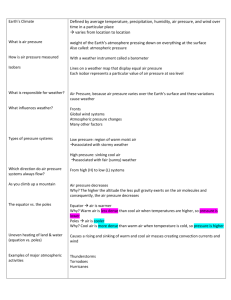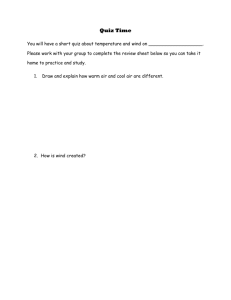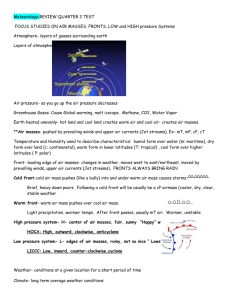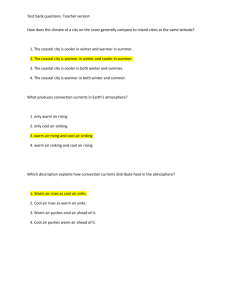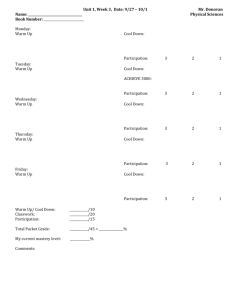P.E.
advertisement
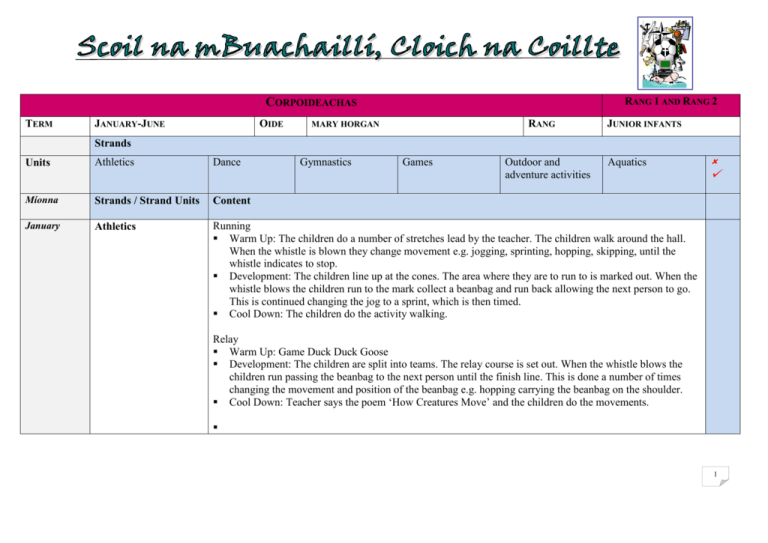
RANG 1 AND RANG 2 CORPOIDEACHAS TERM OIDE JANUARY-JUNE RANG MARY HORGAN JUNIOR INFANTS Strands Units Athletics Dance Gymnastics Games Outdoor and adventure activities Aquatics Míonna Strands / Strand Units Content January Athletics Running Warm Up: The children do a number of stretches lead by the teacher. The children walk around the hall. When the whistle is blown they change movement e.g. jogging, sprinting, hopping, skipping, until the whistle indicates to stop. Development: The children line up at the cones. The area where they are to run to is marked out. When the whistle blows the children run to the mark collect a beanbag and run back allowing the next person to go. This is continued changing the jog to a sprint, which is then timed. Cool Down: The children do the activity walking. Relay Warm Up: Game Duck Duck Goose Development: The children are split into teams. The relay course is set out. When the whistle blows the children run passing the beanbag to the next person until the finish line. This is done a number of times changing the movement and position of the beanbag e.g. hopping carrying the beanbag on the shoulder. Cool Down: Teacher says the poem ‘How Creatures Move’ and the children do the movements. 1 February Athletics Athletics-Sprinting Warm Up: The children are taken out onto the grass and perform a number of stretches led by the teacher. Development: The children are ten dived into pairs and face their partner at the other end of the area. When the teacher says go the children have to sprint to their partners place. The children then all go to one end of the area and have to sprint to the other side starting off with a standing start. Cool Down: The children walk along the running area. Relays & Hurdles Warm Up: The children walk along the grass area and change direction and movement when the whistle is blown. The children do some simple stretches and the teacher divides them into pairs and gives them a beanbag. Development: The children line up opposite their partner. When the whistle child a sprints to his/her partner and hands them a beanbag allowing them to sprint to the other side. This is done a number of times with different partners and is then timed by the teacher. Team Relays: The classes are divided into groups and are given a beanbag. The teacher sets out an obstacle course involving hurdles which then children have to relay race around. This is done a number of times allowing the children to get familiar with the course and is then timed. Cool Down: The children walk around the course. Walking Warm Up: The teacher asks the children to run around saying all the letters of the alphabet. When the whistle blows the teacher calls out a letter and they have to quickly say a word beginning with the letter. The teacher then leads a small stretching activity. Development: The teacher leads the children on a walk around the school grounds explaining about the different places and allowing the children to ask and also answer questions. Cool Down: The children walk back to the classroom. 2 March Outdoor and adventure Outdoor Challenges Directions Warm Up: The teacher shows the children about left, right, forward and backward. The teacher calls out one of these and the children have to run in this direction. The children then form a circle and do some simple stretches lead by the teacherTrust Activity Warm Up: The teacher calls out directions and the children have to sprint that way. They then do some light stretching with the teacher. Development: The children are partnered and one of then is blindfolded. The seeing partner guides the other child around the hall while trying to avoid obstacles. This is then switched. Cool Down: The children close their eyes and guide themselves to the finish line with the rope. Treasure Hunt Warm Up: The teacher explains about the game and the children are put into groups of four. Development: The teacher calls out simple clues and the children have to go to that spot. Once at that spot, the group gets one point and they return to the teacher for the next clue. The group with the most points wins. Cool Down: The children walk around the playground noticing the symbols on the ground. 3 April Games: Ball Games Warm Up: Circle Run. The children are divided into teams of six to eight and make a circle. One player has a ball. On go he/she throws the ball to the next person and then attempts to run around the outside of the circle in reverse direction before the ball is relayed around to it’s starting point. Development: Rounders. Game based on baseball. Cool Down: The children walk around the room saying the alphabet. Chasing Games Warm Up: Chain Tag. One child is picked to be the tagger. The children run around the hall and the tagger tries to catch the others. Once caught, they also become taggers. This is continued till all the children are caught. Development: Cone Tag: Cones are placed randomly around the hall. A chaser area is marked out. There are only three people to be at the cones. The teacher calls out a movement e.g. hopping, crawling etc and blows the whistle. The children now try to move to the next cone without being caught by the chasers. Once caught the child sits out for one round. After each movement the chasers return to the chaser area. Cool Down: The children walk around the hall singing their songs from music. Singing Games Warm Up: The Children begin the game skipping around the gym, hand in hand, with one or two partners, singing the song ‘The More We Get Together’. Every time they sing ‘together’ more friends join together, until everyone is holding hands. At the end of the song all the children form a circle and rush to the middle of the circle, raising their hands way up in the air and singing. Development: Musical Chairs. Cool Down: The children sing the song while skipping around the hall. 4 May Gymnastics Aquatics Forward Roll Warm Up: The safety mats are placed down and the children hops from each one trying not to hit the ground. They then form a circle in the middle and perform a few stretches lead by the teacher. Development: The teacher shows the children how to do the forward roll. The children are then given time to practice this rocking movement until they can do the action independently. Cool Down: The teacher sets up a simple obstacle course that the children have to hop and balance on benches before forward rolling to the finish line, the hall is then cleaned up. Body Awareness Warm Up: The children have to travel using two hands and one foot along a curved pathway. Then sideways in the same position but keeping their bodies low. They then do some stretching. Development: The teacher shows the children the cart wheel and the children have to practice supporting weight on one foot with the body in a stretching position and transferring weight to two hands and one foot with the body in a curled position. Cool Down: The children take turns in practicing the cartwheel. Cart Wheel and Forward Roll Warm Up: The safety mats are placed down and the children hops from each one trying not to hit the ground. They then form a circle in the middle and perform a few stretches lead by the teacher. Development: The children are divided in two. Each group has time to practice the forward roll and then the cartwheel. The teacher then begins timing the children to see which teams finishes both movements first. Cool Down: The teacher asks the children how to make the movement and they walk slowly around the classroom. Using an Apparatus Warm Up: The teacher shows the children the obstacle course and the different movements needed for each part. The children walk the course and then perform stretches lead by the teacher. Development: The children are divided into two teams and perform the obstacle course against each other. Aquatics: Water safety at the beach: Paws programme; PPT. 5 June Dance Exploring Movement Warm Up: As the children know the ‘Maqurina’, they perform this as a warm up activity. Development: The teacher sprinkles magic dust on different parts of the body and when the music plays the children have to make them move in different ways. Cool Down: Playing the music the teacher makes movements that the children have to mirror image. Making a Dance Warm Up: The teacher plays the music and the children have to travel by walking, small steps, wide steps, fast steps, tired steps and bouncing steps. Development: The teacher uses these steps to make a dance corresponding to the music. The dance movements are taught in sequence and performed by the class. Cool Down: the class without the help from the teacher performs The Dance. Saturday Night Fever Warm Up: The Teacher goes through the individual movements of the dance with the children without the music. Development: The teacher now plays the music and the children practice performing their dance a number of times. Cool Down: Once the movements are known, the children perform the dance. Hooky Poky Warm Up: The children perform the dance Saturday Night Fever. Development: The teacher puts on the music of the Hooky Poky and the children listen to it once. It is then played again and the children dance along to the music. Cool Down: The children perform all the dances that they have learned working with this strand of physical education. To add more rows – * Go to Table Tools – Layout and then choose Insert Rows Above or Below – Ensure your cursor is in the row before you start adding rows. 6
